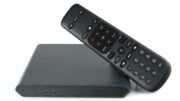DIRECTV has actually had a wireless client for almost 11 years. It first rolled out back in 2013 and my review of it was very positive. In the years since, it’s pretty much stayed the same, with the exception of a new logo on the front on some clients. Things were pretty stable in DIRECTV-land until last year, when the next-generation Gemini box was released. The Gemini is the first DIRECTV satellite device to get video both wired and wirelessly. It’s ignited a decade-old argument about which technology is best, and whether wireless actually even works at all.
Yes, it really does work.
There’s a small group of people who believe that a wireless client couldn’t possibly work. They talk about things like bandwidth and attenuation and traffic. They throw around a bunch of terms hoping to confuse you. The real truth is that a wireless client isn’t that hard to do, especially here in 2023. Let’s take a look at the facts.
Yes there is enough bandwidth.
Let’s talk first about bandwidth. A lot of people will tell you that an uncompressed video stream, such as the one that comes from a DVR and goes over an HDMI connection, is about 10Gbps. They say a typical wireless connection could never support that, and they are right. However, the Genie mini clients actually use a stream about 15Mbps or less for HD. This has been proven by the fact that you can have 7 streams (including 2 4K streams) using the MoCA 1.1 technology built into a Genie. We know MoCA 1.1 has a maximum speed limit of 175Mbps. Bandwidth is definitely not a problem.
Speed isn’t a problem.
DIRECTV’s wireless networking adheres to the old 802.11ac standard (now known as Wi-Fi 5.) This technology is over a decade old and it still has a theoretical max speed of 300Mbps if configured properly. And, DIRECTV’s networking is configured properly. DIRECTV’s wireless content travels on its own network with no other traffic, and uses MIMO antennas so that there’s the best possible throughput.
Yes, even 50 feet away.
So, a wireless DIRECTV connection just needs a sustained speed of about 15Mbps to function. That’s completely achievable with current technology and in fact even with attenuation it’s rarely an issue. Attenuation is the property of a signal where it gets weaker over distance, and with data speeds that usually means it gets slower. So even though you might start with 150Mbps speed from your router, it gets slower as you get further away.
I tested Wi-Fi 6 performance using my own equipment recently. While I could give you a bunch of graphs, the most important thing is that I got 145Mbps everywhere and that’s all that matters. Wi-Fi 6 is more robust than Wi-Fi 5, but even Wi-Fi 5 was excellent within about 50 feet even when three walls are in the way.
No, traffic isn’t a problem.
People say that a wireless client isn’t going to work because all the other Wi-Fi in your home is going to disrupt it. If you’ve ever tried to shop online while the kids are streaming, you know what I’m talking about. I hear you, really. But DIRECTV wireless clients aren’t like streaming devices. The DIRECTV clients use their own wireless network. Even though it’s basically an 802.11ac network, it is completely closed off. It doesn’t interfere with the other networks in your home. Like other wireless networks, it chooses a “channel” to communicate on and will automatically choose another channel if the one it uses is crowded.
Yeah, but does it work?
OK, let’s bottom line it all. I use a mix of wired and wireless clients in my own home. I very rarely notice any difference in performance between the wired and wireless ones. Occasionally I find there’s a short delay after I press a button, but only the first time I press the button.
And the best thing, of course, is that you have options. You can use a Gemini wirelessly or switch to wired if you want. Switching back and forth is relatively easy but depending on which direction you go, you may need to reset the receiver to factory state. Here’s a tutorial on how to do that.
If you’re still having problems with wireless DIRECTV products, we can help! Call the experts at 888-233-7563. We’ll help you with the equipment you have, and if you’d like we’ll talk about upgrades that could make sense for you. Call during East Coast business hours and you’ll get a qualified technician. If it’s after hours, fill out the form below and we’ll get right back to you!





